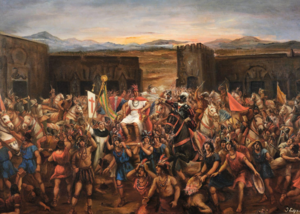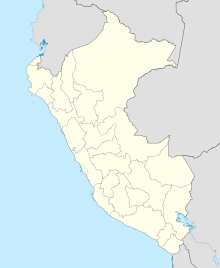
Back Schlacht von Cajamarca German Captura de Atahualpa Spanish Cajamarcako gudua Basque Cajamarcan taistelu Finnish Bataille de Cajamarca French קרב קחאמרקה HE Pertempuran Cajamarca ID Battaglia di Cajamarca Italian კახამარკის ბრძოლა Georgian Pertempuran Cajamarca Malay
| Capture of Atahualpa | |||||||
|---|---|---|---|---|---|---|---|
| Part of the Spanish conquest of Peru | |||||||
 Painting by Juan Lepiani depicting the capture of Atahualpa in Cajamarca. | |||||||
| |||||||
| Belligerents | |||||||
| Spanish Empire | Incas faithful to Atahualpa | ||||||
| Commanders and leaders | |||||||
|
Francisco Pizarro Hernando Pizarro Hernando de Soto | Atahualpa (POW) | ||||||
| Strength | |||||||
|
106 infantry 62 cavalry four cannons 12 harquebuses[1] | 3,000–8,000 guards[2] | ||||||
| Casualties and losses | |||||||
|
1 slave dead;[3] one wounded |
2,000 dead 7,000 taken prisoner | ||||||
Location within Peru | |||||||
The Battle of Cajamarca also spelled Cajamalca[4][5] (though many contemporary scholars prefer to call it Massacre of Cajamarca)[6][7][8] was the ambush and seizure of the Inca ruler Atahualpa by a small Spanish force led by Francisco Pizarro, on November 16, 1532. The Spanish killed thousands of Atahualpa's counselors, commanders, and unarmed attendants in the great plaza of Cajamarca, and caused his armed host outside the town to flee. The capture of Atahualpa marked the opening stage of the conquest of the pre-Columbian civilization of Peru.[9]
- ^ MacQuarrie, Kim (2012). The Last Days of The Incas. Hachette. p. 70. ISBN 978-1405526074.
- ^ Jared Diamond Guns, Germs And Steel, Random House 2013 (p. 76), states that the Inca personnel were purely Atahualpa's personal attendants and nobles, whereas John Michael Francis (2006, Iberia and the Americas: Culture, Politics, and History: a Multidisciplinary Encyclopedia, v. 1, Santa Barbara, Ca.; ABC-CLIO, p. 322) states that they were "ceremonially armed guards".
- ^ Most sources state that no Conquistadors were killed, while others state that five or fewer were killed.(Spencer C. Tucker, 2010, Battles That Changed History: An Encyclopedia of World Conflict, Santa Barbara, Ca.; ABC-CLIO, p. 172.) Among modern sources stating categorically that no Spaniards were killed are (e.g.) Kim MacQuarrie, The Last Days of The Incas, Hachette publishing 2012, p. 84.
- ^ Andagoya, Pascual de. "Narrative of the Proceedings of Pedrarias Davila". The Hakluyt Society. p. 47. Retrieved 21 June 2019 – via Wikisource.
- ^ Delfino, Gianluca (2016). Time, History, and Philosophy in the Works of Wilson Harris. Columbia University Press. ISBN 978-3-8382-6905-4.
- ^ Roa-de-la-Carrera, Cristián A.; Sessions, Scott (2005). Histories of Infamy. University Press of Colorado. ISBN 978-1-4571-0966-9.
- ^ Tandeter, Enrique (2014). La sociedad colonial: Nueva Historia Argentina (in Spanish). Penguin Random House Grupo Editorial Argentina. ISBN 978-950-07-4895-7.
- ^ "Battle of Cajamarca | Summary". Encyclopedia Britannica. Retrieved 2017-07-26.
© MMXXIII Rich X Search. We shall prevail. All rights reserved. Rich X Search


